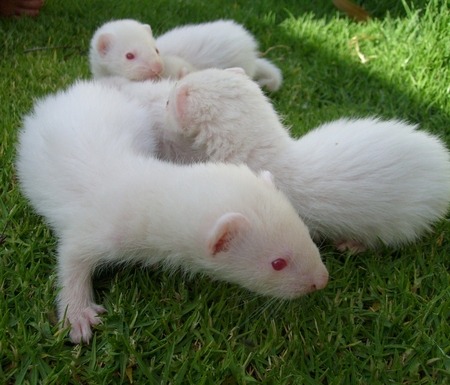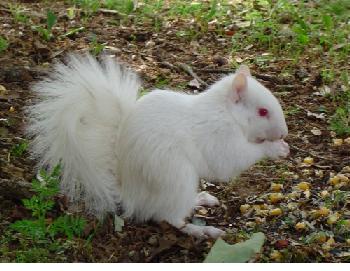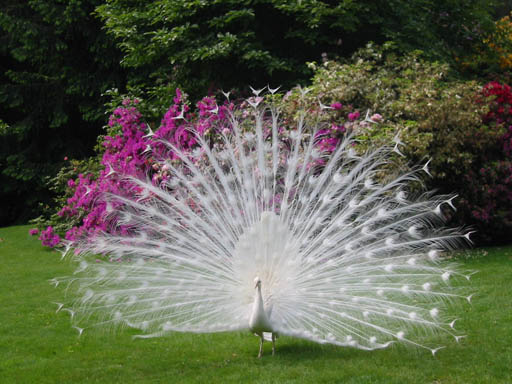|
|
|---|
Friday, December 17, 2010
The real name for these dogs is Xoloitzcuintle, which is pronounced SHOH-loyts-KWEENT-lee. But this name is kind of hard to remember and say, so a lot of people just call the dogs Xolos. This breed has been around for a very, very long time, like more than 3,000 years. The name Xoloitzcuintle comes from an Aztec word, and it means "dog of Xólotl." Xólotl was a god, and he was the twin brother of Quetzalcóatl, who is a little more famous, so maybe you have heard of him. Anyway, since Xólotl was the god of twins and of the deformed, the Xolos' breed name could actually be translated as a dog that is strange or ugly.
But I don't think the Xolos are ugly. They're a little weird-looking because they don't have hair, but it's not their fault that they were born that way. And not all of them are hairless. About one out of four Xolos has a nice, short coat of hair, kind of like a basenji has. Probably all the original dogs in Mexico and Central America had hair, but then there was a mutation in their genes, and that made them start being hairless. Which can be a good thing if you live in a hot place.
The ancient people who lived in that part of the world liked the Xolos because they were good hunting companions, and also they were nice dogs to have around the house. Archeologists have found lots of pottery and stuff that shows these dogs. The Aztecs, Mayans, Toltecs, and some other groups thought the Xolos were sacred, and that they could help their masters' souls travel safely through the underworld. People also thought the dogs had healing powers, and some people still believe that today.
I am sad to say that the Aztecs also liked to eat Xolos. When the Spaniards got to Mexico in the 16th century, they wrote about lots of dogs being served at banquets. Even today, some people in rural Mexico sell dogs for their meat, but this is now illegal, so they are not supposed to be doing it.
Xolos can be really small or really big or any size in between. But here are the three official sizes:
TOY: 10 to 13 inches, 12 to 18 pounds
MINIATURE: 13 to 18 inches, 20 to 25 pounds
STANDARD: 18 to 24 inches, 35 to 45 pounds
And just to make things more confusing, in Mexico, the toy variety is called "miniature" and the miniature variety is called "intermediate."
Hairless Xolos really are hairless, except maybe for a tiny bit of hair on their heads, tails, and feet. They can be any color, but the most common colors are blue, red, or black. And just like the Chinese cresteds, the Xolos don't have as many teeth as normal dogs do.
The AKC registered its first Xolo in 1887. But meanwhile in Mexico, the breed was not very popular, so it almost went extinct. And there weren't all that many of them in the U.S. either. So the AKC dropped the Xolo registration in 1959. But then some people in Mexico got interested in Xolos again and went looking for them in rural areas, and they found enough to get the breed started again. Finally, in 1986, there were enough Xolos in the U.S. for a breed club to get founded, and they asked the AKC to recognize the breed again. But that took awhile, so it was January 1, 2009 when the Xolos were allowed in the AKC Miscellaneous Class. And after that, some other stuff had to be done with the stud book and all that, but the result is that starting January 1, 2011, Xolos can be officially shown in the AKC Non-Sporting Group.
Xolo puppies are kind of wild and crazy, but the adults are calmer. Xolos have some primitive temperament traits, just like basenjis do, such as chasing prey and climbing fences. Xolos also make good guard dogs, and they don't back down from fights.
They are a very healthy breed, and they often live to be 15 or even 20 years old. Their skin doesn't require much care, and in fact if you put too much lotion on it, you can give your dog acne. Also if you give the dog too many baths, you wash off all the natural oils that protect it. If you live in a cold climate, though, you will probably need to put a sweater or jacket on your Xolo.
Okay, well, that's all for now. I think it's about time for me to take a little siesta now. ¡Hasta luego!
But I don't think the Xolos are ugly. They're a little weird-looking because they don't have hair, but it's not their fault that they were born that way. And not all of them are hairless. About one out of four Xolos has a nice, short coat of hair, kind of like a basenji has. Probably all the original dogs in Mexico and Central America had hair, but then there was a mutation in their genes, and that made them start being hairless. Which can be a good thing if you live in a hot place.
The ancient people who lived in that part of the world liked the Xolos because they were good hunting companions, and also they were nice dogs to have around the house. Archeologists have found lots of pottery and stuff that shows these dogs. The Aztecs, Mayans, Toltecs, and some other groups thought the Xolos were sacred, and that they could help their masters' souls travel safely through the underworld. People also thought the dogs had healing powers, and some people still believe that today.
I am sad to say that the Aztecs also liked to eat Xolos. When the Spaniards got to Mexico in the 16th century, they wrote about lots of dogs being served at banquets. Even today, some people in rural Mexico sell dogs for their meat, but this is now illegal, so they are not supposed to be doing it.
Xolos can be really small or really big or any size in between. But here are the three official sizes:
TOY: 10 to 13 inches, 12 to 18 pounds
MINIATURE: 13 to 18 inches, 20 to 25 pounds
STANDARD: 18 to 24 inches, 35 to 45 pounds
And just to make things more confusing, in Mexico, the toy variety is called "miniature" and the miniature variety is called "intermediate."
Hairless Xolos really are hairless, except maybe for a tiny bit of hair on their heads, tails, and feet. They can be any color, but the most common colors are blue, red, or black. And just like the Chinese cresteds, the Xolos don't have as many teeth as normal dogs do.
The AKC registered its first Xolo in 1887. But meanwhile in Mexico, the breed was not very popular, so it almost went extinct. And there weren't all that many of them in the U.S. either. So the AKC dropped the Xolo registration in 1959. But then some people in Mexico got interested in Xolos again and went looking for them in rural areas, and they found enough to get the breed started again. Finally, in 1986, there were enough Xolos in the U.S. for a breed club to get founded, and they asked the AKC to recognize the breed again. But that took awhile, so it was January 1, 2009 when the Xolos were allowed in the AKC Miscellaneous Class. And after that, some other stuff had to be done with the stud book and all that, but the result is that starting January 1, 2011, Xolos can be officially shown in the AKC Non-Sporting Group.
Xolo puppies are kind of wild and crazy, but the adults are calmer. Xolos have some primitive temperament traits, just like basenjis do, such as chasing prey and climbing fences. Xolos also make good guard dogs, and they don't back down from fights.
They are a very healthy breed, and they often live to be 15 or even 20 years old. Their skin doesn't require much care, and in fact if you put too much lotion on it, you can give your dog acne. Also if you give the dog too many baths, you wash off all the natural oils that protect it. If you live in a cold climate, though, you will probably need to put a sweater or jacket on your Xolo.
 |
| Frida Kahlo and her Xolos, c.1944 |
Okay, well, that's all for now. I think it's about time for me to take a little siesta now. ¡Hasta luego!
0 Comments:
Subscribe to:
Post Comments (Atom)























